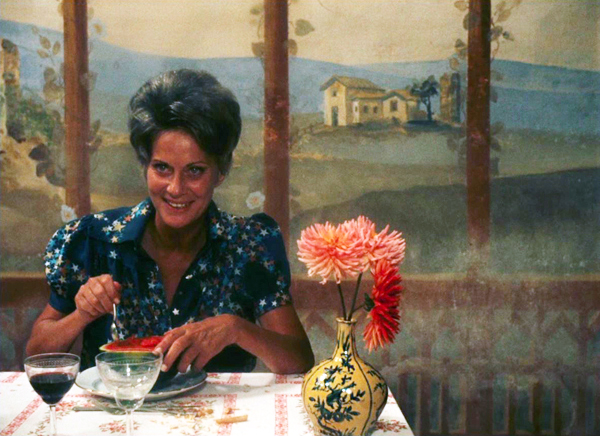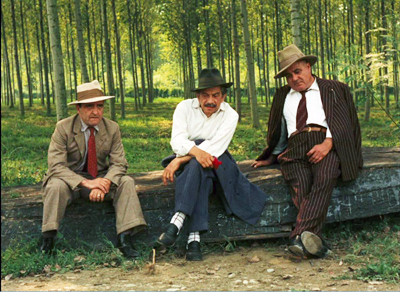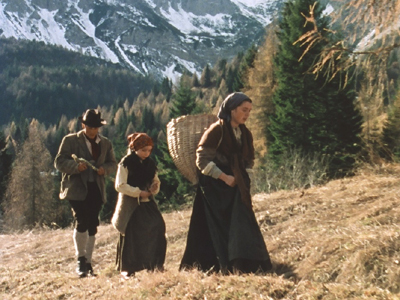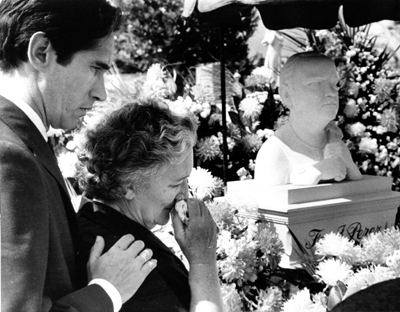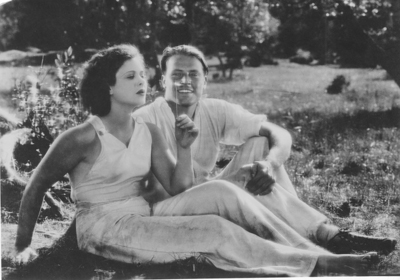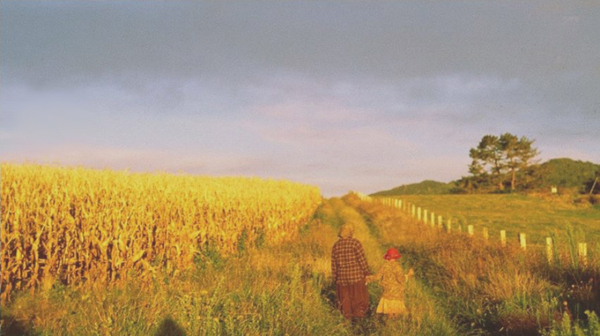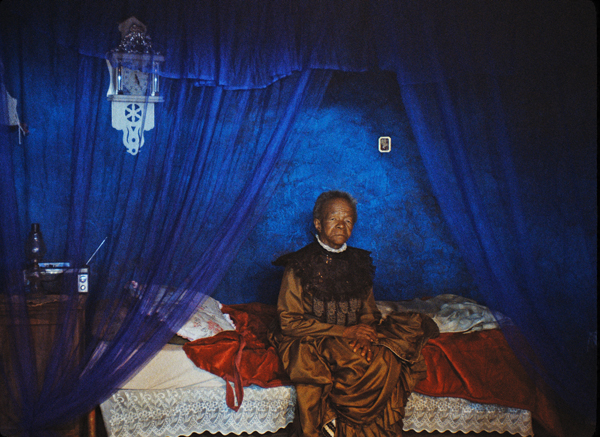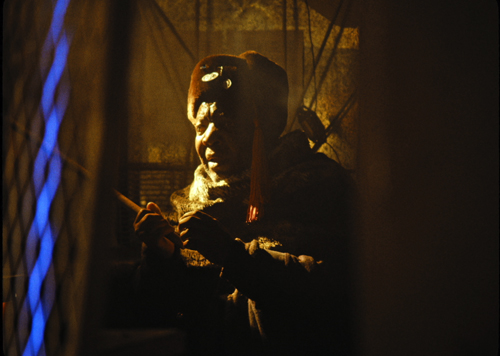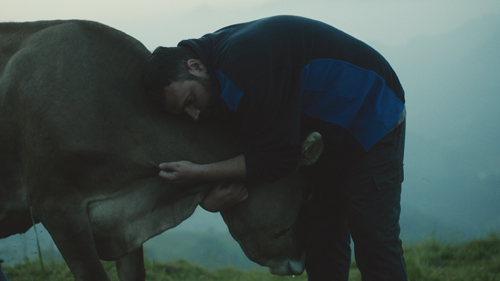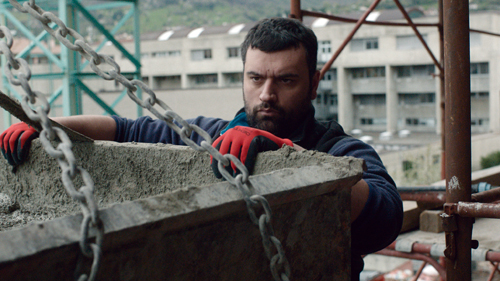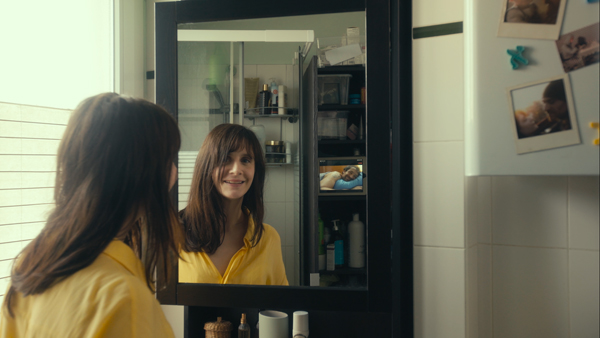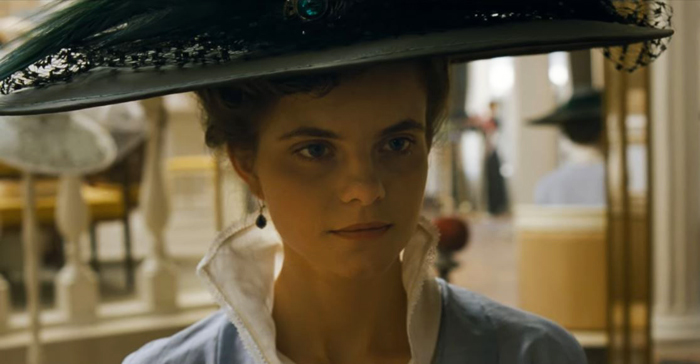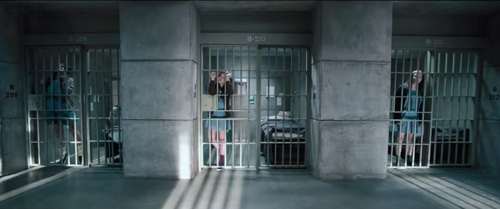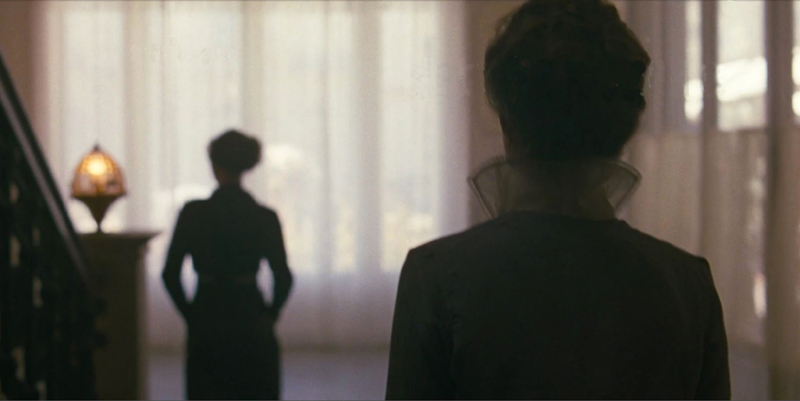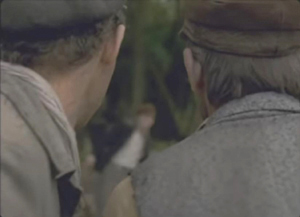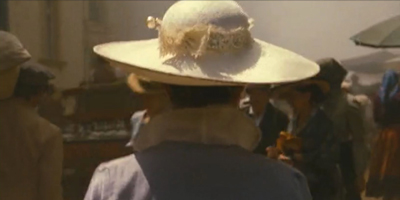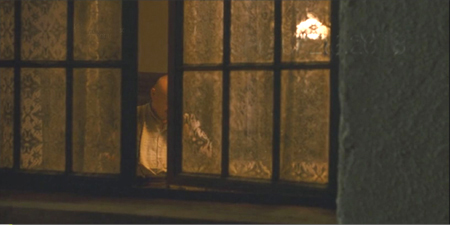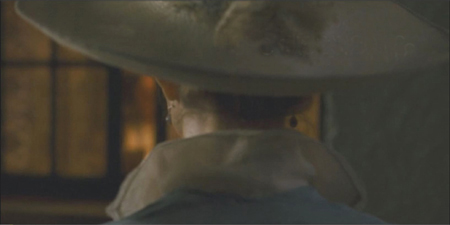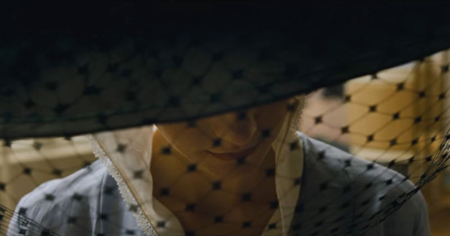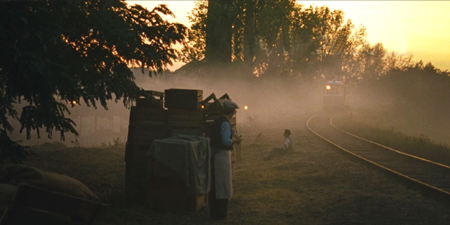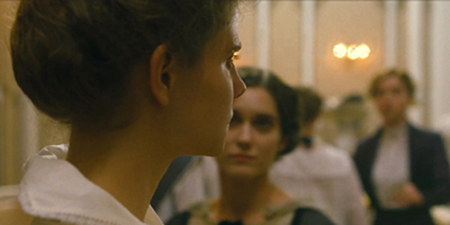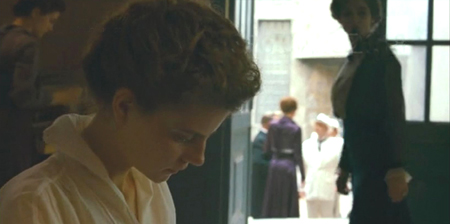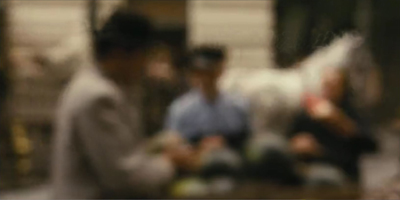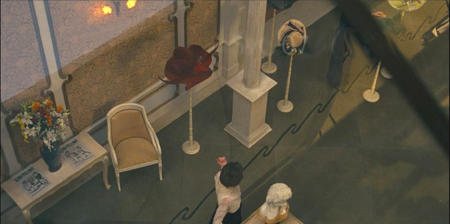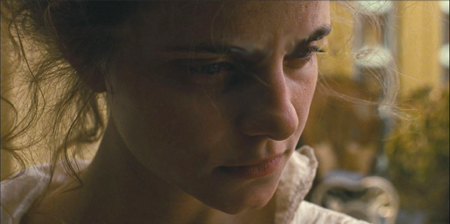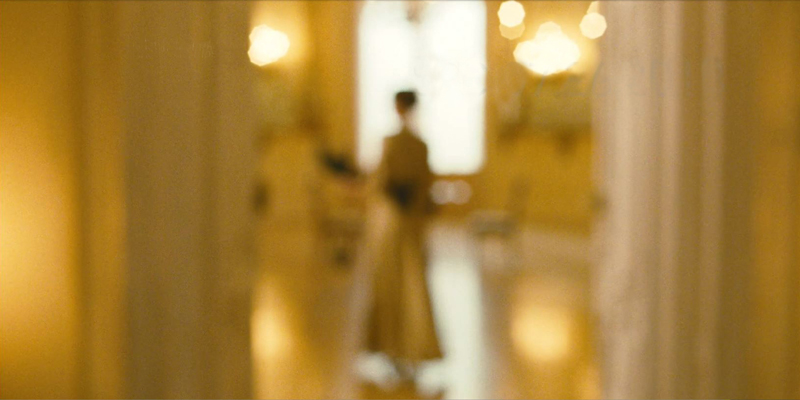Archive for the 'Festivals: Venice' Category
Venice 2019: Repremieres
The Spider’s Strategem (1970).
Kristin here:
The policy at the Venice International Film Festival is to show only world premieres of films. Luckily that includes premieres of restored prints of classic films. These form a major thread in the program here, and this year had been particularly rich in older films that have been unavailable or available only in incomplete or poor prints. We have been catching up with some favorites and were introduced to unfamiliar ones.
The Spider’s Strategem (1970)
Back in the mid-1970s, David and I taught Bernardo Bertolucci’s film, which he made directly after the better-known The Conformist (also 1970). Thanks to the New Yorker print, we came to know it well, and when we wrote Film Art: An Introduction, an example of it went in and has stayed in. David analyzed the film’s storytelling principles at length in Narration in the Fiction Film.
The film came out in VHS versions in the US and UK, both out of print, but it never was released on DVD or Blu-ray. Now it returns in a stunning restoration from Fondazione Cineteca di Bologna and Massimo Sordella. (The restored version is out on Blu-ray in Japan, but without English subtitles.)
The plot involves a young man, Athos Magnani, who returns to the village where his father, who shares his name and appearance, gained a reputation as a bold leader of a small resistance group during the 1930s. He was also mysteriously murdered. The father’s mistress, Draifa, urges his son to stay and investigate the crime, and, it is hinted, to take his father’s place in her bed.
Young Magnani does investigate, but he quickly becomes uncertain as to which villagers were his father’s friends and which his enemies. He also finds himself targeted with threats of violence. Flashbacks mix scenes of past and present with no attempt to differentiate them via period props, changing ages, or stylistic contrasts. The ambiguities, which continue to the end, are not surprising, given that the literary source was a Jorge Luis Borges short story.
Whether or not one enjoys the teasing plot, the visuals are enough to provide delight. The cinematography was done by two major Italian cinematographers: Franco Di Giacomo (The Night of the Shooting Stars, Il Postino) and Vittorio Storaro, known for his bold use of color (Dick Tracy, Tucker: The Man and His Dream, and Tango). The result (see top) is like a blend of classical paintings and an Italian fruit stall.
Now all we need is a Blu-ray release worthy of the print shown here.
Maria Zef (1981)
This was Italian director Vittorio Cottafavi’s penultimate work, made after he has worked almost exclusively in television since the beginning of the 1960s. It has a pleasantly old-fashioned look, perhaps not too surprising in that Cottafavi says he conceived it in 1938, two years after the source novel appeared. He was not able to make it until 1981, when it was seen a project local to the Friuli region of northeastern Italy.
Some internet sources list it as a TV series, but IMDb and others treat it as a film. Certainly it looks like a film and seems to have no obvious pause points. But it was produced by RAI and was shot in the TV-friendly Academy ratio rather than the wider formats that were standard by the 1980s. (While I was watching it, I thought of it as a much earlier film and was surprised to find that it was made so late.)
Maria, an adolescent girl, is traveling with her irrepressible younger sister Rosute and her dying mother. They carry a cart full of domestic implements to sell. The two are taken in by their uncle, Barbe Zef, who made the spoons and other wooden housewares that the trio had been peddling. He’s a gruff fellow, and violent when drunk. Under the influence, he rapes Maria and tries to stifle her subsequent resentment as if his attack had been just a natural impulse.
The film was shot on location in the Italian Alps (above). The region of Friuli will be familiar to many film scholars and buffs who have traveled there for the “Giornate del Cinema Muto” silent-film festival in Pordenone.
The restoration was done by Rai Teche. With luck, the new print will travel abroad and introduce Cottafavi, an Italian favorite, to broader audiences.
[September 10: Thanks to blogger Manfred Polak for providing further information on Maria Zef. He provides a link to a brief piece on the film at the Cineteca de Friuli website. This piece (in Italian) says the film will play at the I Milleocchi festival in Trieste, 13-18 September 2019. The Cineteca also plans a DVD release with numerous supplements. Its earlier release of Vito Pandolfi’s Gli ultimi had optional English subtitles, so perhaps the Maria Zef DVD will as well.]
Mauri (“Life force,” 1988)
This restoration from the New Zealand Film Commission and Park Road Post Production should make available a nearly forgotten classic of New Zealand cinema. It remains the only New  Zealand feature with a Māori woman, Merata Mita, as sole director. (In 1972, To Love a Māori had been co-directed by the husband-wife team Raimi and Rudall Hayward.) Mita had previously made the first feature-length documentary by a Māori woman, Patu! (1983). Much of her career was devoted to documentary filmmaking.
Zealand feature with a Māori woman, Merata Mita, as sole director. (In 1972, To Love a Māori had been co-directed by the husband-wife team Raimi and Rudall Hayward.) Mita had previously made the first feature-length documentary by a Māori woman, Patu! (1983). Much of her career was devoted to documentary filmmaking.
The plot centers largely around an interracial love triangle. Māori woman Ramari is loved by Steve, a white farmer who was schooled alongside Māori children and retained Māori friends as an adult. His father, however, is a rabid and apparently crazy racist who tries a variety of pranks, some violent, to break up the match. Ramari loves a Māori man, Rewa, who harbors a dark secret that prevents him from marrying her.
This drama plays out against the intertwined doings of the family and circle of friends headed by the matriarch Kara. She tries to instill traditional values into her children, grandchildren, and the various troubled people she has treated as her own offspring. The film is set and shot in a tiny, declining village, Te Mata, in the East Cape area of the North Island, south of the now-thriving Hawke’s Bay winery region.
According to the biographical page linked above, “Mita said she had consciously rejected Pākehā traditions of storytelling and embraced a layered approach, in keeping with the strongly oral traditions of Māori. She told writer Cushla Parekowhai: “These are differences that Pākehā critics don’t even take into account when they’re analyzing the film.” Pākehā is the Māori word for white people.
There are rare films, and here I think of Charles Burnett’s To Sleep with Anger, that are entirely set in a specific non-white culture and make no attempt to explain that culture to a white audience. Clearly Mita was trying for the same approach. Her film met with some criticism for not following mainstream conventions of film narrative. Nevertheless, like To Sleep with Anger, Mauri draws in viewers with its drama and appealing characters. Today audiences with a greater openness to other cultures will most likely greet this restored version with greater sympathy and appreciation.
Death of a Bureaucrat (1966)
Tomás Gutiérrez Alea is undoubtedly Cuba’s most famous and revered director. Even those with the most passing knowledge of Cuban cinema will know such titles as Memories of Underdevelopment (1968) and Strawberry and Chocolate (1993). Death of a Bureaucrat is another familiar title, restored by the Academy Film Archive and the Cinemateca de Cuba. The screening was introduced by our old friend Joe Lindner, Preservation Officer at the Academy Archive.
The film is essentially a slapstick farce on a rather unlikely topic, the burial and reburial of the titular bureaucrat. He was a man who distinguished himself by inventing a machine to mass-produce the white busts of political leaders which stand in every government office in Communist countries (and which resemble the bust on the bureaucrat’s tombstone, above). The plot, however, is set off when it is discovered that as a tribute to such a genius, the dead man’s work card has been buried with him, and his widow needs it to receive her benefits.
The rest of the film is a series of escalating efforts by the man’s son to track down the exhumation order which the cemetery officials demand if they are to be able to rebury the body after the card is retrieved. Numerous stamps, signatures, and forms are required, all of which can only be provided by a single person–naturally different in each case. The hero becomes increasingly desperate and begins to try stealth, slipping into an office after closing hours and smuggling his father’s coffin into the graveyard to rebury it himself. All the while the grieving widow gathers all the ice her friends and neighbors can supply to prevent the body, kept at her house, from deteriorating.
The action is amusing enough, including one scene where a hearse is revealed to have a small plastic skeleton dangling from its rear-view mirror. The action does become somewhat repetitious and drawn-out, and one gets the feeling at times that the humor is perhaps aimed at an uneducated audience of workers and peasants, comparable to the Socialist Realism imposed upon filmmakers in the Soviet Union after the 1920s.
It’s interesting that such criticism of the workings of government would be permitted, and yet bureaucratic red tape seem to have been a somewhat safe target for Communist filmmakers, especially if presented as a sort of holdover of bourgeois practices. In the 1920s the Soviets had My Grandmother (Kote Mikaberidze, 1929) and The State Functionary (Ivan Pyriev, 1930), and Death of a Bureaucrat somewhat recalls them.
Extase (1933)
Each of the three years we have visited the Venice International Film Festival, there has been a preliminary evening where a restored early film has been shown. The first year saw the restored Rosita, the second Der Golem, both with orchestral accompaniment. This year there was an early Czech sound film, Gustav Machatý’s Ecstasy.
Having see the film only in the incomplete version that circulated in 16mm in the US for many years, I must say that I had not been impressed. The new restoration by the Národni filmový archiv, with much support from other archives, is a very different film indeed.
The story makes more sense now. It begins with the heroine, played by Hedy Kiesler-Lamarr (as she was then) as a young women who marries a wealthy older man. He turns out to have little interest in passionate love, and she is left on her own to be seduced by a young engineer working on a project near her husband’s estate. The film became famous for its scene of the heroine swimming nude, as well as her first, explicit for its day, love scene with the engineer.
The melodrama works its way out, with the rich man killing himself and the heroine, feeling guilty, leaving her lover. At this point, in the restored print, an abrupt switch to a lengthy sequence shows the engineer returning to work, with a joyous celebration of labor depicted in an imitation of Soviet films of the era. This incongruous ending to the plot comes quite unexpectedly, creating a film very different from the versions available hitherto.
Extase remains a less than wholly satisfactory film, but it now reveals its mixture of various influences of the era: the subjectivity of French Impressionism, the soft style of cinematography from the silent era, and in its ending, the propaganda and montage construction of Soviet cinema. Like Genina’s Prix de Beauté (1930), it’s an early-sound effort to preserve the aesthetics of mature silent cinema.
The evening definitely provided a new, startling version of a hitherto mutilated classic.
Thanks to Paolo Baratta and Alberto Barbera for another fine festival, and to Peter Cowie for the invitation for David to participate in the College Cinema program. We also appreciate the kind assistance of Michela Lazzarin and Jasna Zoranovich for helping us before and during our stay.
Our collaborator Jeff Smith provided a video analysis of another Alea film, Memories of Underdevelopment, for the Criterion Channel. He discusses it in this May blog post.
To go beyond our Venice 2019 blogs, check out our Instagram page.
September 10: Thanks to Hamish Ford and Lee Tsiantis for information concerning The Spider’s Strategem‘s releases on VHS and Japanese Blu-ray.
September 18, 2019: Thanks to Gareth McFeely for corrections on dates and spellings in the section on Mauri.
Mauri (1988).
Finding a form: The College Cinema at the Venice International Film Festival
This Is Not a Burial, It’s a Resurrection (Lemagang Jeremiah Mosese, 2019).
DB here:
For the third year I participated in the Mostra’s College Cinema, a wonderful program that funds and guides three features by up-and-coming directors and producers. (Details are here.) I’ve reported on the earlier sessions here and here.
This year my developing reaction to the trio of features was governed by what Kristin and I did the day before our panel. We saw two superb classics: Bertolucci’s The Spider’s Stratagem (1970) and István Gaál’s Current (1964). They reminded me of what ambitious filmmaking was like before the arrival of screenplay manuals dictating character arcs and first-act turning points.
In those days, a filmmaker was likely to find a distinct, even unique form for a story. The filmmaker would design the film organically, creating a large-scale shape that would let technique and dramatic structure build in relation to each other, not in accord with standard formulas.
Coupling via monitor
A good example is The End of Love, directed by Karen Ben Rafael. The Israeli Yuval and the French woman Julie have a child. He waits in Israel for a new visa, while Julie must manage child care under the pressures of her job in an architecture firm. Each begins to suspect the other of infidelity, and their families in each country add to the tension.
So much for a traditional “relationship” movie, whose ups and downs could have been presented in a standard way. But Rafael and her co-screenwriter Elise Benroubi hit upon a fresh way to trace the couple’s conflicts. Yuval and Julie are keeping in touch via a Skype-like video service, and we are completely confined to their exchanges in this medium. We see only what they see, in a series of to-camera shot/reverse-shots.
Some recent genre films have been “monitor movies,” like Paranormal Activity 4 (2012), Chronicle (2012), Unfriended (2014), and Searching (2018). But these exploit the device for suspense and horror. The End of Love lets the conditions of video communication structure the ongoing drama. A teasing opening suggests that the camera is lying in bed between the couple as they caress themselves; the next scene–a remarkable shot in itself (above)–reveals that video is their channel of communication.
As the film goes along, tensions between Yuval and Julie are presented as much through the mechanics of video exchanges as through the actors’ (very persuasive) performances. Unanswered calls signal a growing indifference. A mysterious shot wobbling through a dance club suggests either a phone accidentally turned on or a loud, defiant assault on the other person. I was especially taken by the moments when we get slight change of eyelines as characters look from the camera to study the display image of the other person.
The End of Love triggers a lot of ideas about how modern couples are led to expect that technology can overcome family problems. Being always online, always “in touch,” doesn’t mean that you’re engaging authentically with someone else. For all its power, the video hookup in the film creates an illusory intimacy, and its glitches stand for the aggravations, little and big, that come with physical separation. This thematic implication grows organically out of the creative decision to confine our viewpoint to what the camera can see and hear, but not heal.
Social drama into community myth
Another vigorous example of letting the material summon up the film’s form is This Is Not a Burial, It’s a Resurrection. Directed, written, and edited by Lemogang Jeremiah Mosese, it’s a poetic work that develops its imagery out of a dramatic situation.
The eighty-year-old Mantoa learns that her only surviving relation, her grandson, has died in a mining accident. After being consoled by her priest and the local choir, Mantoa tries to restabilize her life. But when she learns that her village is to be flooded for a dam project, she vows to save the bodies in the local cemetery–and to prepare her own grave.
This tale, set in Lesotho, is framed by a narrator telling us about her and her community. He sits in a blast of yellow light adjacent to a pool hall, and at intervals the story action pauses for his comments. The film takes its time–about 300 shots in two hours–to dwell on the details of her daily routine, such as the portable radio hanging from the wall, or Mantoa’s changing outfits.
But there are also more surreal images, such as Mantoa on a burned-out bedspring being slowly surrounded by sheep. The community that eventually supports her is presented as an almost abstract force, as are the out-of-focus government workers slowly hacking away at the perimeter of the village. The climax of the film makes powerful use of those figures as Mantoa confronts them in her boldest provocation of all.
Again a familiar situation–a tenacious elder tries to halt the destruction of a community (think Wild River)–is given fresh life through formal elaboration. Out of a primal conflict, Mosese generates a work of mythic dimensions. He does it through lustrous visuals, an evocative soundtrack, and a character who creates a legend that will live for generations.
Town and country
If The End of Love traces a jagged decline in a relationship, and This Is Not a Burial lifts a social conflict into spirituality, Lessons of Love finds another structure, this one aiming to express the inarticulate feelings of a man stuck in a situation. It’s a circle.
Yuri toils on his father’s farm, while his younger brother and sister try to avoid their responsibilities. Stolid, silent, and glum, Yuri harbors a good deal of anger, occasionally expressed in road rage. He relates to the world almost completely through physical contact.
Director Chiara Compara and her co-screenwriter Lorenzo Faggi start from a classic pattern: the migration of an innocent from the countryside to the city. This pattern is refreshed through a strategy going back to Neorealism: the insistence on the physicality of daily routines. A prolonged moment of Yuri tuning a radio recalls the famous scene of the maid’s morning ritual in Umberto D.
The early stretches of Lessons of Love stress the demands of farm work. The first shot is of a milk can, and soon we see logging, veterinary inspections, the purchase of a cow, and the dull evening meal. But we also get a sense of Yuri’s longing when he soberly eats during a TV love scene, and soon enough he’s visiting a strip club, watching as impassively as he did the TV show.
Through a tissue of routines, Yuri’s vague thoughts about escape emerge, and soon he is considering buying cowboy boots, dating Agata, and getting a construction job in town. That’s when the circular structure gets initiated, and new routines replace the old ones. Again, the details of hard labor aren’t stinted, and Yuri is challenged to break out of his smoldering solitude. Can a man who punches and embraces his favorite cow, and who furiously whacks a driver-side mirror, ever learn to talk to a woman who’s kind to him? The last shot of the film, discreetly echoing the first, provides the answer.
A fraught love affair, a defiant elder speaking up for a community’s heritage, and a lonely, locked-in man are familiar enough points of departure for a film. But these three College features offer fresh, rigorous treatment of their stories. Three acts and vulnerable-but-relatable heroes and heroines? Not necessary! There are other ways to go, as young filmmakers can show us.
Thanks as usual to Peter Cowie for inviting me to join the College Cinema panel, and to Savina Neirotti, the Head of the program. Thanks as well to other participants for lively conversation: Chaz Ebert, Glenn Kenny, Mick LaSalle, Michael Phillips, and Stephanie Zacharek. As ever, we appreciate the kind assistance of Michela Lazzarin and Jasna Zoranovich for helping us before and during our stay.
Glenn has a fine appreciation of the College films on rogerebert.com. He too was reminded of Wild River, but no surprise as we’re both nerds in this (and other) respects.
The End of Love (Karen Ben Rafael, 2019).
Some highlights of Venice appear at last
Sunset (2018).
Kristin here:
Going to the Venice International Film Festival in 2017 and 2018 has been a joy. Still, there’s a downside for our readers. We write about the films that premiere there in early September, but the films themselves appear months–sometimes many months–after the festival ends.
Of course, two titles, Roma and The Ballad of Buster Scrugges, appeared fairly soon on Netflix, and First Man had an October opening. After a delay, one of David’s recommended films, Dragged Across Concrete, had a quick, spotty theatrical release and is now available on several streaming platforms, as well as DVD and Blu-ray.
Two others of our Venice favorites are in narrow theatrical release only now, and we think you should seek them out.
The other Manson film to see this year
One film is Mary Harron’s Charlie Says, about the lead-up to and aftermath of the Manson killings. David wrote about it in a report on crime-related films at the festival. We both liked it very much, as a very original approach to the subject. Now Manohla Dargis has published an enthusiastic review, calling the film “powerful and deeply affecting.” Critics have split in their opinions, but we’re with Manohla on this one.
In all the complaints last year over Venice only having one female-directed film in competition, the many women whose films premiered in other threads were largely overlooked. I saw several of them, and I was very glad I put Harron’s film on my viewing schedule.
Seeking out Sunset
My favorite film from the festival was Lázló Nemes’s Sunset. Yes, I loved First Man, Roma, and The Ballad of Buster Scruggs, but Sunset was an instant classic, a film I wanted to see again while I was only a third of the way through the initial viewing.
Usually at festivals we have to include groups of films in each blog entry, even though they deserve more attention. In Sunset‘s case, I waited until I could see a screener and read the interviews with the filmmakers in the special Hungarian journal issue devoted to the film. I devoted a single analytical post to it (which links to an online version of that journal issue).
Without serious spoilers, since it’s a film of mystery and suspense, I tried to convey its unconventional approach to extremely restricted point of view and its brilliant camerawork and design. Many reviewers, however, have dismissed it as baffling or incomprehensible. I obviously disagree. It’s a challenging film, there’s no question about that. But aren’t there great artworks that are challenging in various ways? Works that mystified their original audiences? In order to appreciate them, don’t we expect that we’ll need to experience them more than once or twice? Of course, most reviewers don’t have that option before publishing their responses, but all the more reason to be cautious about condemning something because it’s thoroughly unconventional.
We looked forward to another chance to see Sunset on the big screen, and now it is in release. Its only local venue was at the AMC Classic Desert Star 15 just north of Baraboo, on the edge of the Wisconsin Dells. About 40 minutes of driving brought us to an impressive multiplex from 1999 with a desert theme. The Desert Star name comes from the fact that the theater is located in a much larger Kalihari entertainment complex, with indoor miniature golf, an amusement park with Ferris wheel, and other attractions. An odd venue, but a pleasant one.
For me, on third viewing, the film held up entirely, and I think I figured out a few of the things that had been unclear to me before. I’m sure another viewing will be illuminating as well, though there are clearly ambiguities that can never be resolved, intendedly so. David, seeing it for the second time, was even more impressed than at Venice.
Sunset is not coming out in the UK until May 31. Nemes himself is currently touring theaters showing the film on 35mm (schedule here). It was shot in 35mm and looked great on the huge screen of the Lido’s Sala Grande. Artificial Eye has announced that a Blu-ray will be released in the UK later this year.
Thanks as ever to Michael Barker of Sony Pictures Classics for his help with this and our earlier entry.
AMC Classic Desert Star 15, Baraboo Wisconsin.
Venice 2018: A dazzling second feature
Kristin here:
In my first report from the Venice International Film Festival, I described the excitement of seeing three excellent and quite varied films right in a row, at consecutive early-morning press screenings: First Man, Roma, and The Ballad of Buster Scruggs. We had to wait a whole two days before seeing what may be the masterpiece of this year’s festival–this year’s Zama, as it were.
I’m sure virtually everyone who attended the press/industry screening of László Nemes’s Sunset was wondering whether it would live up to his first feature, Son of Saul (2015), which won, among other prizes, the Oscar for Best Foreign Language film. It’s one of the more deserving winners of that prize in recent memory.
The narration famously concentrates fiercely on the central character, a Hungarian Jew forced to work in a death camp helping to kill and dispose of fellow Jews. The camera follows him from behind or circles to show his face, and keeps most of the horrors occurring around him dimly visible, in the background and on the periphery of the shots, usually out of focus. Mark Kermode praised the technique as a brilliant solution to the problem of not showing those horrors but seeing them reflected in one man’s attention and expressions. We so much admired this rigorous technique that we incorporated Son of Saul into the new fourth edition of Film History: An Introduction.
My suspicion is that many present at that first screening of Sunset in Venice were wondering if Nemes could do anything beyond similarly following a single character around, restricting our point of view in a dazzling exhibition of camera choreography centered on a single intense performance. Well, Sunset is based almost entirely on the camera following (below and top) or weaving around the central character, Írisz Leiter, or framing her face in medium close-ups and close-ups.
There are a many of these “nape-of-the-neck” framings, as we might call them, with only Írisz in focus–and not always her. Again, the point of view is highly restricted to what she sees, hears, and knows. She is present in virtually every shot, or revealed to be nearby. The apparent point of view shot into which the character steps is occasionally used in Hollywood and elsewhere, but here it becomes an insistent technique.
I suspect further that, seeing virtually the same device being used again, reviewers dismissed Sunset as a far less original work than Son of Saul. It helped that the latter was a tale of the holocaust and fairly simple to follow.
In my opinion, Nemes has done something extraordinary. He has taken the same basic approach but turned it to an entirely different use. Now the restricted point of view functions to slowly dole out clues in a complicated double mystery plot. The result is complex, tantalizing, and absorbing.
Sunset is difficult to compare with other films or artworks, since it so very original. It is thoroughly modern art cinema. (Nemes worked as an assistant director to Béla Tarr, though neither of his features reflects any direct influence of Tarr.) It also, however, has something of the air of Feuillade serials. Fantômas was made in 1913, the same year in which Sunset‘s action takes place. Sunset deals with an anarchist gang, and at one point Írisz disguises herself as a man and escapes captivity through an upper-story window. There’s also a considerable streak of Grand Guignol (the theatre that was then building to its height of popularity between the two world wars), with actual and attempted rapes, rumors of a grisly murder, and torch-lit attacks by the anarchist gang.
At least two reviewers have mentioned Mullholland Drive as a comparison point. I don’t think the two films have much in common, apart from their pleasantly puzzling aspects. It’s interesting, though, that reviewers grasped at such a comparison as a way of trying to convey the nature of a very unusual film.
In fact, Nemes has said that Blue Velvet was one of his inspirations. That actually makes far more sense to me, with an innocent gradually witnessing unimaginable cruelties.
What just happened?
The film depends heavily on our gradually getting clues and information as Írisz does, and to avoid spoilers I’m going to be vague describing the plot.
The heroine is the daughter of two founders and owners of Leiter’s, a high-fashion hat shop in Budapest. Orphaned, she has learned hat-making in Trieste and returns to Budapest, aspiring to work in the shop and regain what little connection she can with her parents’ heritage. Her application for a job there opens the film, but she is turned down by the current owner of Leiter’s, Mr Brill.
She soon learns that she apparently has a brother, hitherto unknown to her, who has committed a heinous murder five years earlier. While trying to track down the truth about him, she begins to suspect that Brill may be involved in equally hideous crimes. She spends most of the film wandering about looking for clues and trying to make sense of them.
Sunset is not as puzzling or opaque or illogical as reviewers seem to think. One reviewer refers to it as “befuddling,” which it certainly is not, if one pays careful attention. Lee Marshall, one of those who evoked Mullholland Drive, complains that:
Sunset begins to crumble, to offer itself up to scorn and absurdity, once we start asking questions like “Doesn’t Irisz have regular work hours?” or “How come she always manages to get a lift in a coach just when she needs one?”
In fact there is nothing mysterious about either point. The film makes it quite clear that Írisz is not hired by Brill, even though she offers to work for free. She has no “regular work hours” because she has no job. Brill offers to let her sleep in the Leiters’ rundown house where the store’s milliners live, but he clearly is trying to control her attempts at investigating the dual mysteries. He assigns her tasks to keep her busy, but Zelma, the store’s manager and possibly Brill’s mistress, pointedly tells her when giving her a little task to do, “It doesn’t mean you’re hired.” Another task that he assigns her ends up having to be executed by the other milliners, as Írisz constantly defies Brill by leaving the store and dorm at every opportunity. When Leiter and Zelma tells her not to leave without permission, she inevitably and defiantly departs on another investigative foray. Brill’s description of her as stubborn is a considerable understatement.
As for coaches, Írisz’s brother seems to control an anarchist gang consisting largely of coachmen, some of them with motives to drive Írisz to various destinations. Brill uses his coach to fetch her back to the store and as a setting for lecturing her about not defying him by trying to find her crazed, violent brother. Coaches become another way to try and control her movements.
Such mechanics of the plot are consistently motivated, whether we catch the motivation or not. The script is extraordinarily unified and tight, despite its complexity.
After two viewings, I was glad to discover that I had understood the basic plot on my initial one, although many subtle points were filled in.
Clues–but to what?
The narrative is structured through a chain of clues, which we learn only as Írisz does. Írisz is told something–initially, that she has a brother Kálmán. She tries to follow up that clue but is thwarted for a time. Eventually, wandering about or while accompanying the milliners of the shop to various celebrations of the store’s 30th anniversary, she bumps into people who provide her with new clues. Coincidental meetings and overheard conversations are rife here, but as David has pointed out, that’s how narratives work. If there’s one tradition that Sunset doesn’t belong to, it’s realism.
The other tradition it doesn’t belong to, of course, is classical filmmaking. In a Hollywood film, one clue would lead the protagonist to another and that to another, building the chain that resolves the mystery. The action would move steadily, even when obstacles that thwart the protagonist must be overcome, creating suspense. In Sunset, a clue may intrigue the heroine, but she finds no way to follow up on it. There is a frustrating pause another clue crops up. The sense of progression is thus sporadic and somewhat random, rather than linear and strictly causal.
The overarching ambiguities of the plot arise from the fact that Írisz frequently receives contradictory clues and is unable to decide whether Kálmán and Brill are heroes or villains. At one stage Írisz thinks her brother is a sadistic murderer, but later she begins to suspect he is a hero–and still later she again believes him to be a monster. A similar series of reversals happens with Brill. Thus we may conclude that we understand where the narrative development is headed, only to have our expectations reversed. It also takes quite a long time before we realize that the Kálmán Leiter mystery and the Brill mystery are connected, at which point we must rethink them both.
In a few cases we must even infer a clue that Írisz has been given in the interval between scenes. I must admit that on first viewing I was puzzled as to how Írisz finds where a key player in past action, Fanni, lives. Seeing it again, I realized that the scene where Írisz asks Andor, a young servant at Leiter’s, where she can find Fanni ends with Andor asking eagerly, “Can you make him come back?” He’s referring to Kálmán, whom Andor secretly idolizes. A cut begins a new scene with Írisz approaching the building where she finds Fanni. When she again sees Andor in the following scene, he asks, “Did you find the girl?” Thus it is clear that Írisz told Andor she would try to bring Kálmán back, as she may intend to at this point, and that he gave her the address. It’s not easy to grasp moments like this on the fly, but it’s far from impossible.
The decision to restrict our state of knowledge so thoroughly to that of Írisz, pushing the story to the edge of comprehensibility, was deliberate. In an interview Nemes, he says, “We had an overall strategy: the viewer should go into the labyrinth of the story with the protagonist, in order fo feel the disorientation and defencelessness the protagonist experiences. This subjective aspect is what connects ‘Sunset’ with ‘Son of Saul.'”
Rory O’Connor, writing on The Film Stage, caught the labyrinthine spirit of the film better than have the other reviewers I have read. He realized and accepted that one must re-watch the film in order to appreciate its complexities:
Sunset is a film awash with such delicious ambiguities, almost to the point of damaging its basic cogency at times (not least in simple geographical terms). That said, however disorientated I became while watching Sunset, I never grew frustrated. I did, however, begin to backtrack and second-guess myself just a little, which somewhat diminished the experience (and from speaking to other critics, I was not the only one). Yet the ambiguous will always face such early criticisms–just look at Mullholand Dr.–and I not only plan on seeing Sunset again; I will relish the challenge.
This is exactly what great art films can do: make us relish the challenge.
Seeing and yet not seeing
The film is easy to relish, given its original, systematic stylistic elements.
The cinematography has been widely admired, even by those who otherwise dislike the film. The long takes with the camera moving smoothly along with Írisz through crowded streets or circuitous interiors are virtuoso shots, justifying the use of consistently handheld camera as few films have done.
Beyond that, though, the tactic of throwing most planes of the scene out of focus is used in nearly every shot, so that we are forced intensely to concentrate on Írisz. This way we actually see even less than Irisz does, but we are not distracted from the dogged obstinacy and reckless courage of her quest.
The minute control of planes of action is masterly (above and below).
Throwing certain planes out of focus can become a motif (if one watches closely enough). Zelma is often seen out of focus in the backgrounds of scenes. In the frame at the top of this entry, she escorts Írisz to meet with Brill in the opening scene, when Írisz is applying for a job at Leiter’s. Zelma hovers in the middle ground in the frame at the top of the this section; in the frame just above, she’s in the distance, greeting the royalty from Vienna. She is seen for the last time disappearing into a soft, distorting view (bottom of the entry), going to either a posh job attending royalty or a grim fate. As usual, we have no way of knowing which, though we may suspect. The composition hauntingly recalls the early shot of her escorting Írisz, at the top.
I spotted only one shot where Írisz is wholly absent, late in the film, and that is a single tracking movement in the street inserted between two scenes. Nothing is in focus. By following Írisz we may not see everything, but without her we see even less.
Interestingly, Nemes and the cinematographer, Mátyás Erdély, originally intended to try and find an approach quite different from that of Son of Saul:
When we finished ‘Son of Saul’ and began to talk about ‘Sunset,’ we definitely wanted to do something that was very different. For example, if the aspect ratio was 1:1.37 in ‘Son of Saul,’ then it should be anamorphic 1:2.39 in ‘Sunset’; if ‘Son of Saul’ was to be photographed with a handheld camera, then let’s use the dolly for ‘Sunset.’ We made a mood test film, but the camera was in my hands already for the second shot. We realised that the kind of approach that László likes and that matches ‘Sunset’ requires that the camera be hand-held. We decided in advance that there would be dolly and anamorphic, however, in vain–in the end, it was 1:1.85 and a hand-held camera.
The film was shot in 35mm, with the final shot that constitutes the epilogue being set apart by filming on 65mm. Some release prints are available on film, and that’s what we saw in Venice. It was one of only two films shown on 35mm (the other being Vox Lux). See it on film if you possibly can. It’s gorgeous.
I unfortunately haven’t seen Son of Saul on the big screen, but Sunset is clearly a very different sort of film, much more epic in scale. It had a considerably bigger budget and is an historical piece about a beautiful, crowded city. The central set, Leiter’s Hat Store, depicts the luxurious goods that the upper classes and even royalty purchase. The filmmakers built Leiter’s in a vacant lot in a small street in Budapest’s Palace District, behind the National Museum. That way characters could exit the store and be followed by the camera into the bustling street lined with buildings that existed in 1913. As László Rajk, the production designer, says,
The space of ‘Son of Saul’ is an enclosed universe, the strict but also intimate world of the concentration camp. ‘Sunset,’ on the other hand, takes place in an open world, with all the sounds and noises of a big city. This means that in this film we–sound designer and production designer alike–had to create a completely different, open and noisy universe which reflects much less intimacy.
The amazing thing is that the designer took all this trouble and expense even though the lack of focus meant that most of the surroundings, both the built hat store and the real streets, would usually be only dimly visible to the audience. As Rajk adds, however, “those who played–and practically lived–their parts within [the store’s] walls had to believe every single second that they were in the year 1913, in Budapest, at its most elegant hat store full of secrets.”
We do occasionally see the store’s interior in focus, as in this, one of the two true point-of-view shots I spotted in the film:
Still, I would be hard put to figure out that layout of Leiter’s Hat Store or guess where the house where Írisz and the other milliners live is in relation to it.
If there’s one thing that reveals the vast difference between Son of Saul and Sunset, it’s that in the former we dread to see the offscreen, out-of-focus, peripheral things that are happening. In the latter, we yearn for a view of the crowded streets of Budapest and the splendid decor of Leiter’s Hat Shop. We are frustrated, channeled into watching Írisz but having a constant sense of the city which we glimpse occasionally in focus and more frequently in an evocative haze.
I look forward to relishing a third viewing.
As always, thanks to Paolo Baratta, Alberto Barbera, Peter Cowie, Michela Lazzarin, and all their colleagues for their warm welcome to this year’s Biennale.
Many thanks also to Michael Barker and Allison Mackie of Sony Pictures Classics for their help in preparation of this entry.
My quotations come from the interviews with the filmmakers in Hungarian Film Magazine (Autumn 2018), pp. 10, 11, 16, 17, 21. Nearly all of this issue is devoted to revealing interviews with the director, star, cinematographer, set designer, costume designers, and sound designer. In Venice, this issue was provided to the press, and it is available in its entirety online here.
Some photos from our Venice jaunt are on our Instagram page.












